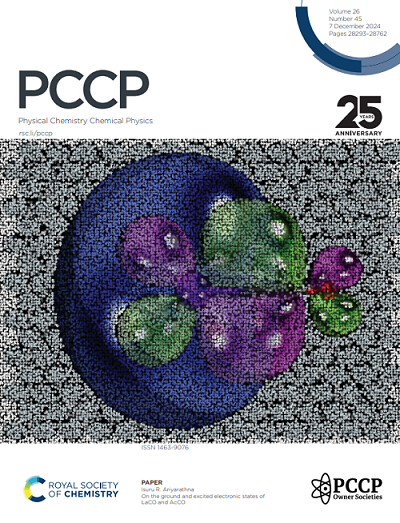IF 2.9
3区 化学
Q3 CHEMISTRY, PHYSICAL
引用次数: 0
摘要
对溶解在稀释配准介质中的分子的阶次参数以及各向异性 NMR 数据进行预测,可为解决某些具有挑战性的结构阐释问题提供独特的方法。在此,我们开发了一种基于溶质-介质相互作用的通用预测模型,其特点是只使用介质特定参数作为拟合变量来描述配准系统中的分子间相互作用,包括溶质与介质聚合物之间的排斥、分散和静电作用,以及它们与隐含溶剂之间的相互作用。该模型是在表面分解方法的框架上实现的,该方法是在没有介质结构先验知识的情况下,将介质诱导的溶质配准形式化而设计的。新模型拥有所有相互作用的描述符,当介质和溶质表现出强烈的静电和分散相互作用时,新模型的性能明显优于原始的硬体模型。该模型提供了一种通用方法,通过结合不同模型化合物的核磁共振实验数据,提取介质聚合物的物理特性,然后利用这些特性预测其他相关分子的核磁共振数据。本文章由计算机程序翻译,如有差异,请以英文原文为准。
A Comprehensive Solute-Medium Interaction Model for Anisotropic NMR Data Prediction
Prediction of order parameters and hence anisotropic NMR data of a molecule dissolved in a dilute alignment medium can provide a unique means of solving certain challenging structural elucidation problems. Here, a general prediction model based on solute-medium interactions is developed featuring the use of medium-specific parameters as only fitting variables to depict intermolecular interactions in an alignment system, including repulsive, dispersive, and electrostatic interactions between the solute and the medium polymer, as well as their interactions with implicit solvent. This model is implemented on the framework of a surface decomposition method previously designed to formalize medium-induced solute alignment without a priori knowledge of medium structure. Having descriptors for all interactions, the new model performs significantly better than the original hard-body model when the medium and solute exhibit strong electrostatic and dispersion interactions. This model offers a general method to extract physical properties of a medium polymer by combining the experimental NMR data of different model compounds and then use these properties to predict the NMR data of other molecules of interest.
求助全文
通过发布文献求助,成功后即可免费获取论文全文。
去求助
来源期刊

Physical Chemistry Chemical Physics
化学-物理:原子、分子和化学物理
CiteScore
5.50
自引率
9.10%
发文量
2675
审稿时长
2.0 months
期刊介绍:
Physical Chemistry Chemical Physics (PCCP) is an international journal co-owned by 19 physical chemistry and physics societies from around the world. This journal publishes original, cutting-edge research in physical chemistry, chemical physics and biophysical chemistry. To be suitable for publication in PCCP, articles must include significant innovation and/or insight into physical chemistry; this is the most important criterion that reviewers and Editors will judge against when evaluating submissions.
The journal has a broad scope and welcomes contributions spanning experiment, theory, computation and data science. Topical coverage includes spectroscopy, dynamics, kinetics, statistical mechanics, thermodynamics, electrochemistry, catalysis, surface science, quantum mechanics, quantum computing and machine learning. Interdisciplinary research areas such as polymers and soft matter, materials, nanoscience, energy, surfaces/interfaces, and biophysical chemistry are welcomed if they demonstrate significant innovation and/or insight into physical chemistry. Joined experimental/theoretical studies are particularly appreciated when complementary and based on up-to-date approaches.
 求助内容:
求助内容: 应助结果提醒方式:
应助结果提醒方式:


